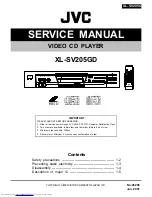
8
avoid accidental starting.
■
Never use in an explosive atmosphere.
Normal
sparking of the motor could ignite fumes.
■
Inspect tool cords periodically.
If damaged, have
them repaired by a qualified service technician at an
authorised service facility. If repair or replacement
of the electric cord or plug is necessary, do not
connect the equipment-grounding conductor to a live
terminal. Repair or replace a damaged or worn cord
immediately. Stay constantly aware of cord location
and keep it well away from the rotating blade.
■
Keep tool dry, clean, and free from oil and grease.
Always use a clean cloth when cleaning. Never use
brake fluids, gasoline, petroleum-based products, or
any solvents to clean tool.
■
Never start a tool when any rotating component is
in contact with the workpiece.
■
Do not operate a tool while under the influence of
drugs, alcohol, or any medication.
■
When servicing,
use only identical replacement
parts. Use of any other parts may create a hazard or
cause product damage.
■
Use only recommended accessories
listed in
this manual or addendums. Use of accessories that
are not listed may cause the risk of personal injury.
Instructions for safe use of accessories are included
with the accessory.
PLANER SAFETY WARNINGS
■ Always wear eye protection when operating the
machine.
■ Check to make sure all holding screws are tight before
starting machine.
■ Always stop the motor and disconnect from the power
source before making any adjustments.
■ Be sure all guards are in place before operation.
■ Read operator's manual thoroughly and familiarise
yourself with the machine before operation.
■ Do not force work through the machine. Allow the
planer to apply the proper feed rate.
■ Check feed rollers occasionally to be sure sawdust
and chips are not lodged between any components. If
rollers are not seated firmly, the feed rolls will not hold
timber firmly against the bed, allowing kickback.
■ Check and make sure the roller tables are on the same
plane with the work table when planing wood, and the
rollers can rotate freely when planing long workpieces.
■ Only plane wood boards.
■ Use sound timber, with no loose knots and as few tight
knots as possible.
■ Never stand directly in line with either the infeed or
outfeed sides. Always stand off to one side of the
machine.
■ Make sure the workpiece is free of nails, screws,
stones and other foreign objects which could damage
the blades.
■ Make sure the blades are attached correctly as
described in the instructions.
■ Use caution when handling the blades and cutterhead
assembly. The blades are sharp and can easily cut
your hand.
■ Allow the cutterhead to reach full speed before using.
■ Use the push stick instead of your hands to push the
workpiece when its end approaches the blades. The
push stick should be stored on the work table when
not in use.
WARNING
Never conduct the following operations:
■ Stopped work (i.e., any cut which does not involve
the full length of the workpiece)
■ Planing recesses, tenons or moulds
■ Planing badly bowed wood with inadequate contact
with the infeed table
ANTI-KICKBACK PAWLS
See figure 2.
■ An anti-kickback pawl is a device which, when
properly installed and maintained, is designed to stop
the workpiece from being kicked back toward the front
of the blade during a planer operation.
AVOIDING KICKBACK
■ Always use the correct blade depth setting.
Inspect the work for knots or nails before beginning a
cut. Knock out any loose knots with a hammer. Never
cut into a loose knot or nail.
■ Always use clean, sharp, and properly-set blades.
■ Never use planer with dull blades.
■ To avoid pinching the blade, support the work properly
before beginning a planer operation.
■ When planing use steady, even pressure. Never force
the planer.
■ Do not plane wet or warped timber.
■ Always hold your workpiece firmly with both hands,
keep your body in a balanced position to be ready to
resist kickback. Never stand directly in line with timber.































